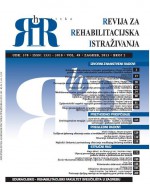Percepcija visokoškolske nastave pristupačne studentima s invaliditetom
Perception of higher education teaching process accessible to students with disabilities
Author(s): Andrea Fajdetić, Lelia Kiš Glavaš, Natalija LisakSubject(s): Education
Published by: Sveučilište u Zagrebu, Edukacijsko-rehabilitacijski fakultet
Keywords: higher education; students with disabilities; adjustment
Summary/Abstract: The aim of the research is to find previous knowledge and experiences as well as recommendations of the junior faculty staff about teaching competencies in higher education that contribute to higher education accessibility (planning, realization and evaluation). Taking into consideration the aim of the research the target group are junior faculty staff who’ve only started their professional development and who, if lead systematically, can reach the optimal quality level expected in order to meet every student’s needs. The paper will present the results of the qualitative research related with reasonable adjustments in higher education and other activities that might contribute to the quality of education through creating support for students with disabilities. The research sample are junior faculty staff (research assistants, assistants and lecturers) employed by the Faculty of Education and Rehabilitation Sciences of the University of Zagreb, that teach courses of B.A and M.A. programs within scientific field of education and rehabilitation sciences. We have used qualitative methods of collection and analysis of data in this paper. A focus group interview was made with 8 junior staff members, and anonymity in the process of the audio-taping and answer analysis has been guaranteed (Creswell, 1998). The themes covered in the interview are: being informed about students with disability, experience of work with students with disabilities, competencies for work with students with disabilities and planning, realization and evaluation of teaching process in higher education. The analysis strategies are: conducting insights from collected materials, fi nding codes in the material, reducing information by creating categories, finding connections between the categories and making a logical matrix of the research findings and an analytical overview of the theoretical findings (Bogdan, Biklen, 1992, Huberman, Miles, 1994, Wolcott, 1994; cited in Creswell, 1998). The results will provide insights into the current state and needs for specific competencies for teaching according to the principles of universal design. The conclusion will provide guidelines that will increase the quality of the higher education and providing equal opportunities to students with disability by respecting knowledge, experience and recommendations of the junior staff in the institution of higher education with a rich experience of work with students with disability.
Journal: Hrvatska revija za rehabilitacijska istraživanja
- Issue Year: 49/2013
- Issue No: 2
- Page Range: 28-41
- Page Count: 14
- Language: Croatian

